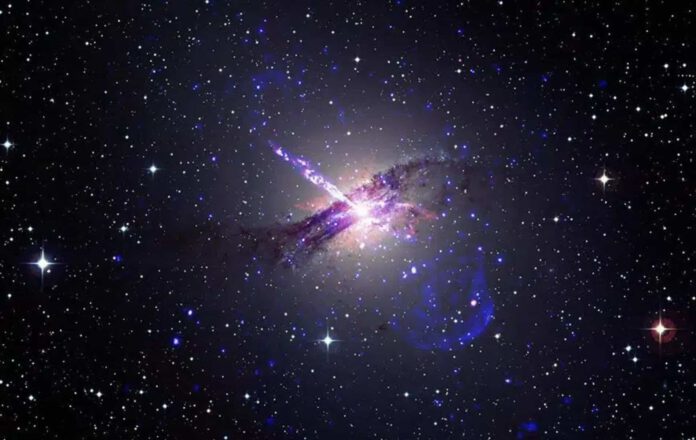
In this stunning composite image, partially created by the Chandra X-ray Observatory, we are presented with an impressive view of the galaxy Centaurus A. Also known as NGC 5128, this galaxy is located approximately 12 million light-years from Earth and is among the nearest radio galaxies. This image was selected in honor of Chandra’s 25th anniversary, marking its crucial role in X-ray astronomy since its launch in 1999.
About Centaurus A
Centaurus A is a lenticular galaxy with an elliptical shape, spanning about 300,000 × 450,000 light-years, roughly 3 to 4.5 times the diameter of our Milky Way. From Earth, this galaxy can only be viewed from the southern hemisphere, in the constellation Centaurus. At its core lies a supermassive black hole with a mass of 55 million solar masses, emitting two gigantic jets of high-energy particles.
In the center of the photo, this central black hole can be seen as a bright white dot. From this center, the jet spewing towards the upper left is clearly recognizable as a purple/white fountain. Surrounding the entire galaxy, a translucent blue cloud can be seen, most prominently in the lower right of the photo. These are the remnants of the ejected material. Both the jets and the cloud have been extensively studied and photographed by Chandra.
The Chandra X-ray Observatory
The Chandra X-ray Observatory satellite, launched on July 23, 1999, by Space Shuttle Columbia into an elliptical orbit around Earth, is one of NASA’s Great Observatories. This group of space telescopes also includes James Webb and Hubble. While Chandra excels in X-ray photography, other telescopes cover different parts of the electromagnetic spectrum to create the most comprehensive views possible.
Through Chandra’s X-ray photography, groundbreaking observations of highly energetic processes in the universe, such as neutron stars, black holes, and supernova remnants, have been made over the past 25 years. Since high-energy radiation from distant objects is deflected, scattered, and nearly entirely blocked by our atmosphere and the Van Allen belts, comparable observations from the ground are impossible. Consequently, Chandra was placed in a unique elliptical orbit, ranging from 16,000 to 133,000 kilometers above Earth. This enables the observatory to make observations for 85 percent of its 64-hour orbit, as long as it remains above the Van Allen belts.
Chandra’s Unique Contribution
Below is the same image, but rendered solely from Chandra’s data. This underscores the unique value of Chandra in revealing high-energy processes that are invisible to optical telescopes.
X-ray Photography in Astronomy
The total composition shows the spectacular jet of particles escaping the supermassive black hole, a phenomenon comparable to that observed in other active galaxies such as Messier 87 (M87). The image of M87’s central black hole, taken by the Event Horizon Telescope, provides insight into the extremely energetic events occurring around supermassive black holes and highlights the importance of X-ray observations.
Chandra’s contribution to astronomy remains undeniable, and this composition of Centaurus A is a beautiful example of the complexity and beauty of our universe.
Click here to download a high-resolution image of the composite photo.
In recent decades, space telescopes and satellites have captured breathtaking photos of nebulae, galaxies, stellar nurseries, and planets. Every weekend, we select a fascinating space photo from the archives. Want to enjoy all the photos? Check them out on this page.











